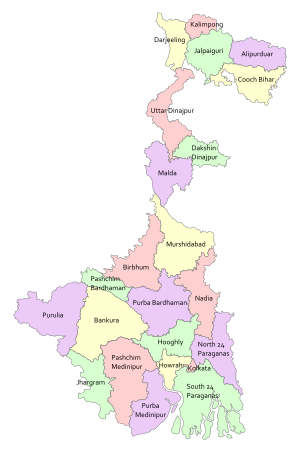
The Himalayas lies in the north of West Bengal and the Bay of Bengal is at the south. Between them, the river Ganga flows eastwards and its main distributary, the Hooghly River, flows south to reach the Bay of Bengal. The Siliguri Corridor, which connects North-East India with rest of the India, lies in the North Bengal region of the state. Geographically, West Bengal is divided into a variety of regions—Darjeeling Himalayan hill region, Terai and Dooars region, North Bengal plains, Rarh region, Western plateau and high lands, coastal plains, Sundarbans and the Ganga Delta.[1]
In 1947, when India gained independence, the state of West Bengal was formed, with 14 districts, as per partition plan of the then Bengal province of British India.[2][3] The former princely state Koch Bihar joined as a district on 26 January 1950,[4] and the former French enclave Chandannagore joined as part of the Hooghly district in 1954.[5] The States Reorganisation Act of 1956 led to addition of Purulia district to the state and to enlargement of West Dinajpur district.[6] Later, larger districts such as West Dinajpur, 24 Parganas and Midnapore were bifurcated.
West Bengal is now divided into 23 districts which includes the newly formed Alipurduar district (formed on 25 June 2014), Kalimpong district (formed on 14 February 2017), Jhargram district (formed on 4 April 2017), and the splitting of the former Bardhaman district into Purba Bardhaman district and Paschim Bardhaman district (formed on 7 April 2017). The districts are grouped into five divisions.[7][8]
Divisions are administered by Divisional Commissioners.[9] Kolkata, the capital of the state, constitutes the Kolkata district. Other districts are further divided into administrative units such as subdivisions and blocks, administered by SDO and BDO, respectively. The Panchayati Raj has a three-tier structure in the state. The atomic unit is called a Gram Panchayat, which is the Panchayat organisation for a collection of villages.[10] The block-level organisations are called Panchayat Samiti,[11] and the district-level organisations are named Zilla Parishad.[12]
The West Bengal cabinet has approved the creation of seven new districts on 1 August 2022. This will number district from 23 to 30.[13] New Sundarban District from existing South 24 Parganas District, new Ichhamati District and Basirhat District from existing North 24 Parganas District. New Ranaghat District from existing Nadia District and Bishnupur District from existing Bankura district. While new Jangipur District and Berhampore district from existing Murshidabad District will be carved out.
- ^ Cite error: The named reference
swhydrowas invoked but never defined (see the help page). - ^ Cite error: The named reference
parttionbanglapedwas invoked but never defined (see the help page). - ^ Cite error: The named reference
partitionspoilwas invoked but never defined (see the help page). - ^ Cite error: The named reference
CBEwas invoked but never defined (see the help page). - ^ Cite error: The named reference
Chanderwas invoked but never defined (see the help page). - ^ Cite error: The named reference
PFwas invoked but never defined (see the help page). - ^ "The Statesman: Alipurduar to become Bengal's 20th dist". Archived from the original on 14 July 2014. Retrieved 21 June 2014.
- ^ "Roy Alipurduar: Alipurduar a new district on June 25 | Kolkata News – Times of India". The Times of India.
- ^ Cite error: The named reference
blocdirwas invoked but never defined (see the help page). - ^ Cite error: The named reference
gpdefwas invoked but never defined (see the help page). - ^ Cite error: The named reference
psdefwas invoked but never defined (see the help page). - ^ Cite error: The named reference
zpdefwas invoked but never defined (see the help page). - ^ "Explained: 7 new districts in West Bengal — how and why are districts created or abolished in India?". The Indian Express. 1 August 2022. Retrieved 2 August 2022.